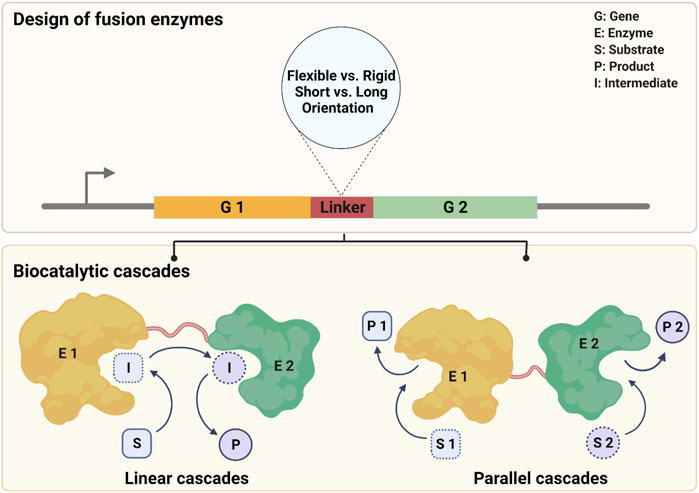Enzyme Fusion Design is a groundbreaking biochemical technique that involves the combination of two or more enzymes to augment their functionality. The fusion of enzymes can lead to a substantial increase in enzyme stability, significant improvement in catalytic activity, or even enable the enzymes to catalyze entirely new reactions. These enhancements open up potential applications in various industries, such as pharmaceuticals, biofuels, and food processing.
 Design of fusion enzymes for two biocatalytic cascade processes (Yu Ma, et al., 2022)
Design of fusion enzymes for two biocatalytic cascade processes (Yu Ma, et al., 2022)
Service Process
The technical route for Enzyme Fusion Design is an intricate process that involves a series of meticulously planned steps to ensure the successful creation of fusion enzymes:
1. Initial consultation to thoroughly understand your unique requirements: Our team of seasoned experts will engage in an in-depth discussion with you about your needs and desired outcomes. They will seek to understand the specifics of what you hope to achieve with the fusion enzymes, enabling us to produce a tailored solution.
2. Identification and selection of suitable enzymes for fusion: Following the consultation, our knowledgeable team will conduct extensive research into potential enzymes for fusion. This rigorous process ensures that we identify and select enzymes that are the perfect fit for your specific requirements.
3. Intricate design and construction of the fusion enzymes: Once the ideal enzymes are selected, our highly skilled team will embark on the meticulous task of designing and constructing the fusion enzymes.
4. Expression and purification of the fusion enzymes: After the fusion enzymes have been designed and constructed, we move on to their expression and purification. Utilizing standard, yet effective, biochemical techniques, the fusion enzymes are expressed and purified to the highest standards.
5. Comprehensive testing and optimization of the fusion enzymes: Rigorous testing and optimization processes are carried out on the fusion enzymes to assure their quality and efficacy.
6. Final delivery of the optimized fusion enzymes: Following thorough testing and optimization, the fusion enzymes are ready for final delivery.
We're here to assist you. If you have any questions, need more information, or would like to discuss a potential project, please don't hesitate to contact us. Our team is always eager to help and share our expertise.
Applications
| Application |
Description |
| Biocatalysis |
Enzyme Fusion Design finds widespread application in biocatalysis, where it enables the engineering of multifunctional enzymes with enhanced catalytic properties. By fusing two or more enzymes with complementary activities, researchers can create synergistic enzyme complexes capable of catalyzing complex reactions in a single step. This approach streamlines biocatalytic processes, improves reaction efficiency, and expands the substrate scope, facilitating the synthesis of valuable chemicals, pharmaceuticals, and biofuels. |
| Metabolic Engineering |
Enzyme Fusion Design is applied in metabolic engineering to engineer metabolic pathways and biosynthetic routes for the production of desired compounds. By fusing enzymes involved in sequential metabolic steps, researchers can enhance pathway flux, reduce metabolic intermediates, and improve product yields. This approach enables the construction of tailor-made biosynthetic pathways for the production of bioactive compounds, pharmaceuticals, and biochemicals. |
| Protein Engineering |
Enzyme Fusion Design plays a key role in protein engineering, where it facilitates the design of novel enzymes with improved catalytic properties and substrate specificity. By fusing protein domains with complementary functions, researchers can create chimeric enzymes with enhanced stability, activity, and selectivity. This approach enables the engineering of enzymes for specific applications, such as enzyme therapeutics, bioremediation, and biocatalysis. |
| Synthetic Biology |
Enzyme Fusion Design is utilized in synthetic biology to engineer synthetic metabolic pathways and cellular systems for various biotechnological applications. By fusing enzymes with orthogonal activities, researchers can construct artificial biosynthetic pathways for the production of novel compounds, biomaterials, and biofuels. This approach enables the design of custom-tailored cellular chassis for synthetic biology applications, such as biosensing, bioremediation, and metabolic engineering. |
| Drug Discovery and Development |
Enzyme Fusion Design is employed in drug discovery and development to engineer enzymes for therapeutic applications and drug delivery systems. By fusing enzymes with targeting ligands or therapeutic proteins, researchers can create multifunctional enzyme conjugates with enhanced pharmacokinetic properties and target specificity. This approach enables the development of novel enzyme-based therapies for the treatment of various diseases, including cancer, metabolic disorders, and infectious diseases. |
FAQs
In order to provide a more in-depth understanding of our services, we have compiled an extended list of frequently asked questions regarding Enzyme Fusion Design:
Q: What are the benefits of Enzyme Fusion Design?
A: Enzyme Fusion Design can significantly increase the stability of enzymes, leading to a longer lifespan and making them more resistant to environmental conditions. It can also enhance their catalytic activity which results in greater efficiency and faster reaction times. Furthermore, it can enable enzymes to catalyze completely new reactions, expanding their range of use. This results in more efficient processes and superior products in various industries, making Enzyme Fusion Design a vital technique in modern biochemical applications.
Q: Can any two enzymes be fused together?
A: The process of fusing enzymes is not arbitrary. The suitability of enzymes for fusion depends on a variety of factors, including their structures, functions, and compatibility. Each enzyme has a specific 3D structure and function, and these factors need to be compatible for a successful fusion. Therefore, not all enzymes can be fused together. This highlights the importance of the initial step in the Enzyme Fusion Design process, which is the careful identification of suitable enzymes for fusion.
Q: How are fusion enzymes expressed and purified?
A: The process of expressing and purifying fusion enzymes is meticulous. Fusion enzymes are typically expressed in suitable host organisms, such as bacteria or yeast. After expression, the fusion enzymes are then purified using standard biochemical techniques. This includes steps like centrifugation, filtration, and chromatography. These methods ensure the purity and effectiveness of the fusion enzymes, removing any unwanted substances and ensuring that they function as intended.
Q: What industries can benefit from Enzyme Fusion Design?
A: The benefits of Enzyme Fusion Design can be harnessed by a wide range of industries. These include pharmaceuticals, where it can aid in the production of complex drug molecules; biofuels, where it can enhance the efficiency of biofuel production; food processing, where it can be used to develop novel food products or improve existing processes; and even in the textile industry, where it can help in the development of environmentally friendly dyes and finishes.
Q: Can the process be customized according to specific needs?
A: Absolutely. Our Enzyme Fusion Design service is flexible and can be tailored according to your specific needs and requirements. From the selection of enzymes to the design and construction of the fusion enzymes, every step can be customized to achieve the desired outcome. We work closely with our clients to understand their expectations and deliver results that meet or exceed these expectations.
Q: How long does the Enzyme Fusion Design process typically take?
A: The duration of the process can vary depending on the complexity of the fusion and the specific requirements of the project. It typically takes several weeks to months from the initial consultation to the final delivery of the fusion enzymes.
Q: Are there any potential risks or drawbacks involved in Enzyme Fusion Design?
A: As with any scientific technique, there can be challenges. These might include potential incompatibility between the fused enzymes, or issues with the expression and purification process. However, our expert team is well-versed in troubleshooting these challenges to ensure a successful outcome.
Q: Do you offer support after the delivery of the fusion enzymes?
A: Yes, we offer comprehensive after-delivery support. This includes troubleshooting, optimization advice, and further customization if needed.
Q: Can the fusion enzymes be scaled up for industrial use?
A: Yes, the fusion enzymes that we design and develop can be scaled up for industrial applications. We work closely with clients to ensure that the enzymes are suitable for their intended application and scale of operation.
Q: Is Enzyme Fusion Design environmentally friendly?
A: Yes, one of the advantages of Enzyme Fusion Design is that it can contribute to more sustainable processes. By enhancing the efficiency and durability of enzymes, it can lead to processes that require less energy, produce less waste, and reduce the need for harmful chemicals.

































 Design of fusion enzymes for two biocatalytic cascade processes (Yu Ma, et al., 2022)
Design of fusion enzymes for two biocatalytic cascade processes (Yu Ma, et al., 2022)